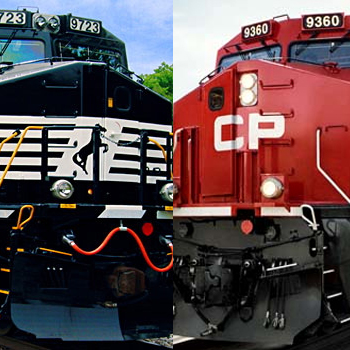Canadian Pacific Officially Confirms Interest in Acquiring Norfolk Southern

Norfolk Southern has confirmed it received an unsolicited, low premium, non-binding highly conditional indication of interest from Canadian Pacific to acquire the company.
A recent Bloomberg report indicating that Canadian Pacific Railway Ltd. (CP) is looking to acquire Norfolk Southern (NS) was confirmed by the Class I railroads in separate statements issued over the past two days.
NS confirmed it had “received an unsolicited, low premium, non-binding highly conditional indication of interest from [CP] to acquire the company for $46.72 (per share) in cash and a fixed exchange ratio of 0.348 Canadian Pacific shared per Norfolk Southern share.”
The Norfolk, Va.-based railroad carrier also said its board of directors, in consultation with its financial and legal advisors, will carefully evaluate and consider this indication of interest in the context of Norfolk Southern’s strategic plans and its ongoing review of opportunities to enhance stockholder value through strategic, financial and operational measures and pursue the best interests of the Company and its stockholders.
NS pointed out that consolidation among Class I railroads in North America would face significant regulatory hurdles.
Earlier today, CP released the offer letter written by its CEO Hunter Harrison to NS CEO James Squires on Nov. 17, with detailed information on a proposal that it said would create a pro-competitive, pro-customer, coast-to-coast transportation.
“We believe that combining our two great organizations will allow us to form an integrated transcontinental railroad with the scale and reach to deliver unprecedented levels of safety and service to our customers while also creating competition and significant shareholder value,” - Canadian Pacific Railway Ltd. CEO Hunter Harrison
The CP CEO said that CP’s proposal is a 50 percent cash, 50 percent stock transaction based on last Friday’s closing stock price for both companies.
In a Nov. 17 statement issues by CP whose purpose was to confirm CP’s interest in NS, CP said that it believes the combined railroad would offer unparaelled customer service and competitive rates that will support the success of shippers and industries it serves and also satisfy U.S. Surface Transportation Board and Canadian regulators.
Other benefits of this deal cited by CP included:
- a new approach to terminal access that would change the status quo in U.S. rail transportation, explaining that in the event the new company failed to provide adequate service or competitive rates, it would allow another carrier to operate from a point of connection over the combined company’s tracks and into its terminals, providing an unprecedented alternative to the affected shipper;
- the new company would give shippers the choice of where they can connect with another railroad along its network, bringing an end to the practice of “bottleneck pricing” to a large number of shippers in the U.S. while further enhancing competition;
- a combination would alleviate the long-standing issue of congestion in Chicago, which seized into gridlock in the winter of 2014 and hobbled economic growth. By channeling rail traffic away from Chicago, CP would create fluid routes through under-utilized hubs and free up much-needed capacity for other railroads that pass through the city, providing them with new, efficient and competitive service options for their own customers, with a combined CP/NS creting capacity for all shippers without creating the need for more infrastructure; and
- an efficient end-to-end freight shipment solution will also improve safety, reduce highway congestion, and allow the rail industry to play an even greater role in the revival and sustained recovery of the North American economy
In addressing the first aforementioned benefit by CP, Tony Hatch, principal of New York-based ABH Consulting said that directly offering up open access in the form of reciprocal switching/bottleneck accesses essentially mirrors the proposal the National Industrial Transportation League has made to the STB, which has been rejected by various parties, including the Association of American Railroads, as well as CSX and NS.
Hatch also called this new approach a “stunner” in that if CP-NS service was not up to snuff or rates were not competitive, it would allow another carrier to operate over its tracks and into its terminals.
Other factors not working in the deal’s favor, explained Hatch, included how “in the last, and most, periods of service problems, additional access would have been, to say the least, counterproductive (in a congested region, more assets= more problems),” and that “in an ever-increasing service requirement business, added complexity isn’t optimal – is it?”
This does not mark the first time CP has tried to make a large-scale North American railroad acquisition.

In October 2014, it was reported that CP approached CSX about a potential merger but talks stalled out. Save for the Berkshire Hathaway $26 billion acquisition of BNSF Railway in 2010, railroad M&A has been largely quiet on that front.
Had that deal eventually been consummated, the total market value of CP and CSX would be $62 billion, according to a Wall Street Journal report.
This development came at a time when the railroad sector, despite various service-related issues, was doing very well, due in large part to the ongoing emergence of crude oil-by-rail (CBR) at the time, which had seen volume gains throughout the sector, as evidenced by the U.S.-based Class I railroads generating $2.15 billion in moving CBR in 2013, which was far ahead of 2008’s $25.8 billion, according to federal data cited in the WSJ report.
This merger would have likely faced multiple obstacles if CP continued to pursue CSX, due to intervention from the U.S. Department of Transportation’s Surface Transportation Board (STB). This occurred in 2000, when a proposed merger between Burlington Northern and CP was halted due to resistance from the STB, according to the WSJ report.
Other obstacles cited included national security concerns, given that national security officials would be expected to closely examine any proposed deal “under laws governing foreign ownership of infrastructure such as railroads that is deemed critical.”
The WSJ report said CP’s Harrison stated at an investor conference that M&A in the railroad makes sense as it would help in aiding Chicago interchange congestion issues, which is the key rail connector between East and West Coast Ports.
And with the current balance of power in North America among the Class I railroads - two in the east, 2 in the west, one in the middle, and 2 in Canada - an industry stakeholder said in a previous interview that has created a very stable playing field, but were one of the legs of this “table” to be pulled, it would require some sort of response among the other members of the supporting cast, which he said is not likely in their best interests.
What’s more, the stakeholder said that deals like this tend to have limited value, coupled with a business case not strong enough to overcome other considerations. And on top of that the freight railroad sector has shrunk from 56 Class I railroads in 1975 to seven in 2005, according to a New York Times report.
Cowen and Company analyst Jason Seidl wrote in a research note that a CP-NS merger could be beneficial for both carriers in the long-term, despite the fact that a big rail transaction typically involves a tough integration phase, while also noting that shippers may be less vehemently opposed to a merger now compared to a year ago, when service was much worse. And he also said that a merger proposal would have a better chance of succeeding today it did when CP tried to acquire CSX.
“The fall of 2014 was not the ideal time for such an effort to be launched, primarily because both shippers and regulators were disenchanted with the rail industry due to severe service and capacity issues, which emerged late in 2013 and did not start abating in any material sense until 2015. CP’s reported move to join forces with NSC will likely still trigger service concerns with shippers who will recall service challenges associated with past transactions, including those encountered by CSX in 1997 when it integrated parts of Conrail into its network after a fight over the acquisition of the company with NSC.”
Related: Rail Still Dominates the Logistics Landscape

Article Topics
ABH Consulting News & Resources
LM Podcast Series: Examining the freight railroad and intermodal markets with Tony Hatch Examining the freight railroad and intermodal markets with Tony Hatch 13th Annual Rail/Intermodal Roundtable: Emerging optimism? STB introduces new service-focused reciprocal switching NPRM 2023 State of Logistics: Rail/Intermodal Rail Carload and Intermodal Market Report with Tony Hatch State of Logistics 2022: Rail/Intermodal More ABH ConsultingLatest in Transportation
Baltimore Bridge Collapse: Impact on Freight Navigating Amazon Logistics’ Growth Shakes Up Shipping Industry in 2023 Nissan Channels Tesla With Its Latest Manufacturing Process Why are Diesel Prices Climbing Back Over $4 a Gallon? Luxury Car Brands in Limbo After Chinese Company Violates Labor Laws The Three Biggest Challenges Facing Shippers and Carriers in 2024 Supply Chain Stability Index: “Tremendous Improvement” in 2023 More TransportationAbout the Author













